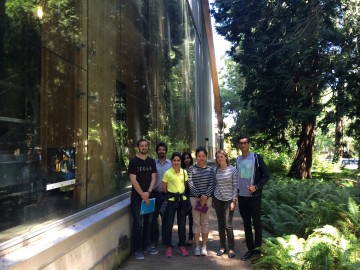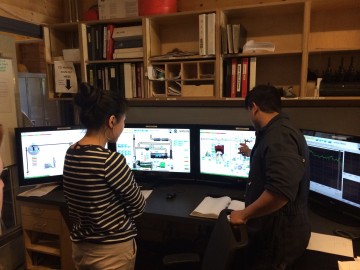 The ERMP research group had the opportunity to tour the BRDF facility on June 16th to learn about other energy conservation initiatives, especially those so close to home. On the tour, the group learned about the technical aspects of the facility, as well some of the current sustainability initiatives.
The ERMP research group had the opportunity to tour the BRDF facility on June 16th to learn about other energy conservation initiatives, especially those so close to home. On the tour, the group learned about the technical aspects of the facility, as well some of the current sustainability initiatives.
The Bioenergy Research Demonstration Facility (BRDF) at UBC is the first biomass cogeneration—or combined heat and power, CHP—project of its kind in North America. The facility is the first to clean and condition biomass (urban wood waste) into an engine fuel grade synthesis gas, or syngas, on a commercial scale.
The facility’s heat and power system, fueled by biomass, creates syngas that’s then burned, in raw form, to produce steam. Or, the syngas is conditioned to create ultra clean syngas that’s injected into an internal combustion engine used to generate electricity.
How the BRDF Works
Operational since 2012, the $27.4 million facility processes two to three truckloads of ground and chipped waste wood daily, consisting of sawmill residuals, municipal trimmings and land clearing operations.
The BRDF has two modes of operation, which produce energy for campus use:
- Thermal Only Mode: produces 6 megawatts (MW) of thermal energy (steam) per hour. Thermal Only Mode uses commercially proven gasification technology to turn biomass into syngas.
- Biomass Cogeneration (CHP) Mode: produces 2.4 MW of thermal energy (heat recovery) and 2 MW of electricity. In CHP mode, raw biomass syngas is refined to produce an engine grade or clean syngas—using a custom made syngas cleanup technology—which is used by the BRDF engine.
Visit the BRDF Frequently Asked Questions page for more details on each operating mode.
Monitoring Emissions
The BRDF has demonstrated that the cleaner the fuel source is, the cleaner the emissions are. A real-time ambient air monitor has been installed in a nearby building to ensure emissions from the facility remain at safe levels for the surrounding buildings and residents. The monitor provides alerts if air quality limits are exceeded. Air emissions from the facility have fallen well below permitted emission limits to date.
Maximizing Performance and Returns
The latest development at the BRDF is the use of Renewable Natural Gas (RNG). When syngas is not available, RNG fuels the cogeneration process as a complementary fuel source to syngas. RNG is classified as a biofuel, the same as biomass. The RNG cogeneration dual fuel project was commissioned by UBC in July of 2014.
The use of RNG allows operators to maximize the thermal and cogeneration modes of operation at the same time. The BRDF can now produce up to 8.4 MW (thermal) and 2MW (electricity).
The facility will provide a positive return on UBC’s investment by 2028. The BRDF will generate over $800,000 in operational savings annually, which will be used to pay down the University’s $8.15 million contribution to the overall project over 15 years.
